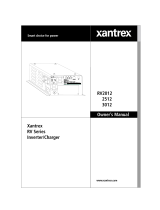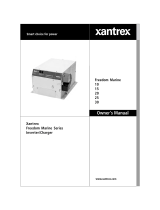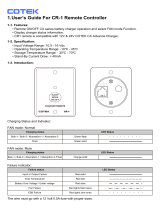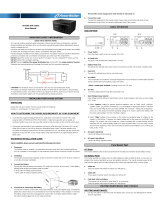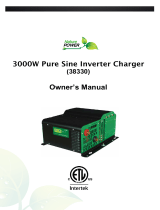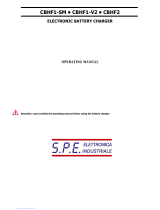Page is loading ...

Freedom HW 1000
Inverter/Charger
Owner’s Guide


Freedom HW 1000
Inverter/Charger
Owner’s Guide

About Xantrex
Xantrex Technology Inc. (www.xantrex.com), a subsidiary of Schneider Electric, is a world leader in
the development, manufacturing and marketing of advanced power electronic products and systems for
the renewable and mobile power markets. The company's products convert and control raw electrical
power from any central, distributed, renewable, or backup power source into high-quality power
required by electronic equipment and the electricity grid. Xantrex is headquartered in Vancouver,
Canada, with facilities in the United States, Germany, Spain, and a joint venture in China.
About Schneider Electric
As a global specialist in energy management with operations in more than 100 countries, Schneider
Electric offers integrated solutions across multiple market segments, including leadership positions in
energy and infrastructure, industrial processes, building automation, and data centres/networks, as well
as a broad presence in residential applications. Focused on making energy safe, reliable, and efficient,
the company's 120,000 employees achieved sales of more than 17.3 billion euros in 2007, through an
active commitment to help individuals and organizations “Make the most of their energy™”.
Trademarks
Xantrex, Freedom, Smart Choice for Power, and Make the most of their energy are trademarks of
Schneider Electric Services International sprl, registered in the U.S. and other countries.
Other trademarks, registered trademarks, and product names are the property of their respective owners
and are used herein for identification purposes only.
Notice of Copyright
Xantrex Freedom HW Inverter/Charger Owner’s Guide © December 2008 Xantrex Technology Inc. All
rights reserved. No part of this document may be reproduced in any form or disclosed to third parties
without the express written consent of: Xantrex Technology Inc., 5917-195th St NE, Arlington, WA
98223. Xantrex Technology Inc. reserves the right to revise this document and to periodically make
changes to the content hereof without obligation or organization of such revisions or changes unless
required to do so by prior arrangement.
Exclusion for Documentation
UNLESS SPECIFICALLY AGREED TO IN WRITING, XANTREX TECHNOLOGY INC. (“XANTREX”)
(
A) MAKES NO WARRANTY AS TO THE ACCURACY, SUFFICIENCY OR SUITABILITY OF ANY TECHNICAL OR
OTHER INFORMATION PROVIDED IN ITS MANUALS OR OTHER DOCUMENTATION.
(
B) ASSUMES NO RESPONSIBILITY OR LIABILITY FOR LOSSES, DAMAGES, COSTS OR EXPENSES, WHETHER
SPECIAL, DIRECT, INDIRECT, CONSEQUENTIAL OR INCIDENTAL, WHICH MIGHT ARISE OUT OF THE USE OF
SUCH INFORMATION. THE USE OF ANY SUCH INFORMATION WILL BE ENTIRELY AT THE USER’S RISK; AND
(C) REMINDS YOU THAT IF THIS MANUAL IS IN ANY LANGUAGE OTHER THAN ENGLISH, ALTHOUGH
STEPS HAVE BEEN TAKEN TO MAINTAIN THE ACCURACY OF THE TRANSLATION, THE ACCURACY CANNOT
BE GUARANTEED. APPROVED XANTREX CONTENT IS CONTAINED WITH THE ENGLISH LANGUAGE
VERSION WHICH IS POSTED AT WWW.XANTREX.COM.
Date and Revision Document Part Number Product Number
December 2008 Rev A 975-0467-01-01 806-1055
Contact Information
Telephone: 1 800 670 0707 (toll free North America)
1 408 987 6030 (direct)
Fax: 1 800 994 7828 (toll free North America)
Email: [email protected]
Web: www.xantrex.com

iii
About This Guide
Purpose
The purpose of this Owner’s Guide is to provide explanations and
procedures for operating, maintaining, and troubleshooting a Freedom
HW Installation*.
For complete information to help in setting up a Freedom HW Installation
see the Freedom HF Inverter/Charger Installation Guide (Doc. Part
Number: 975-0468-01-01).
* Recreational or Fleet Vehicle installation.
Scope
The Guide provides safety guidelines, as well as information about
operating and troubleshooting the installation. It does not provide details
about particular brands of batteries. You need to consult individual battery
manufacturers for this information.
Audience
The Guide is intended for users and operators of the Freedom HW
Inverter/Charger unit.
Organization
This Guide is organized into five chapters and one appendix.
Chapter 1 introduces you to the Freedom HW, explains the inverting,
charging, and power system management functions.
Chapter 2 contains information and labeled illustrations to help identify
the various features of the Freedom HW.
Chapter 3 explains how to configure the Freedom HW to best meet your
electrical system requirements.

About This Guide
iv 975-0467-01-01
Chapter 4 explains how to operate the Freedom HW efficiently and
effectively.
Chapter 5 describes how to troubleshoot the Freedom HW Inverter/
Charger during operation.
Appendix A contains electrical performance information and product
specifications.
Conventions Used
The following conventions are used in this guide.
Related Information
You can find more information about Xantrex Technology Inc. as well as
its products and services at www.xantrex.com
WARNING
Warnings identify conditions or practices that could result in personal injury or
loss of life
CAUTION
Cautions identify conditions or practices that could result in damage to the unit or
other equipment.
Important:
These notes describe things which are important for you to know,
but not as serious as a caution or warning.

v
Important Safety Instructions
READ AND SAVE THIS OWNER’S GUIDE FOR FUTURE
REFERENCE.
This chapter contains important safety and operating instructions for the
Freedom HW Inverter/Charger unit.
1. Before installing and using the Freedom HW, read all instructions and
cautionary markings on the Freedom HW, the batteries, and all
appropriate sections of this guide.
2. Do not expose the Freedom HW to rain, snow, spray, or bilge water.
To reduce risk of fire hazard, do not cover or obstruct the ventilation
openings. Do not install the Freedom HW in a zero-clearance
compartment. Overheating may result.
3. To avoid a risk of fire and electric shock, make sure that existing
wiring is in good condition and that wire is not undersized. Do not
operate the Freedom HW with damaged or substandard wiring.
4. The use of any attachments not recommended or sold by Xantrex,
may result in risk of fire, electric shock, or injury to persons.
5. Do not operate the Freedom HW if it has received a sharp blow, been
dropped, or otherwise damaged in any way. If the Freedom HW is
damaged, see the Warranty section.
WARNING: Limitations on use
The Freedom HW is not intended for use in connection with life support systems
or other medical equipment or devices.
CAUTION: Risk of injury
To reduce the risk of injury, charge only 12 Vdc lead-acid (GEL, AGM, or
Flooded) rechargeable batteries. Other battery types may burst, causing personal
injury and damage.

Safety
vi 975-0467-01-01
6. Do not disassemble the Freedom HW. It contains no user-serviceable
parts. See Warranty for instructions on obtaining service. Attempting
to service the Freedom HW yourself may result in a risk of electrical
shock or fire and will void your warranty. Internal capacitors remain
charged after all power is disconnected.
7. To reduce the risk of electrical shock, disconnect both AC and DC
power from the Freedom HW before attempting any maintenance or
cleaning or working on any circuits connected to the Freedom HW.
Turning off controls will not reduce this risk.
8. The Freedom HW must be provided with an equipment-grounding
conductor connected to the AC input ground.
1. Working in the vicinity of batteries is dangerous. Batteries generate
explosive gases during normal operation. Therefore, it is of utmost
importance that each time before servicing the unit in the vicinity of
the battery, that you read this manual and follow the instructions
exactly.
2. This equipment contains components which tend to produce arcs or
sparks. To prevent fire or explosion, do not install the Freedom HW
in compartments containing batteries or flammable materials, or in
locations that require ignition-protected equipment. This includes any
space containing gasoline-powered machinery, fuel tanks, as well as
joints, fittings, or other connections between components of the fuel
system.
3. To reduce the risk of battery explosion, follow these instructions and
those published by the battery manufacturer and the manufacturer of
any unit you intend to use in the vicinity of the battery.
WARNING: Explosion hazard

Safety
975-0467-01-01 vii
Personal Precautions When Working With Batteries
1. Study and follow all of the battery manufacturer's specific
precautions, such as removing or not removing cell caps while
charging, and recommended rates of charge.
2. Add distilled water in each cell until battery acid reaches the level
specified by the battery manufacturer. This helps to purge excessive
gas from cells. Do not overfill. For a battery without cell caps,
carefully follow manufacturer's recharging instructions.
3. Make sure the area around the battery is well ventilated.
4. Never smoke or allow a spark or flame near the engine or batteries.
5. Use extra caution to reduce the risk or dropping a metal tool on the
battery. It could spark or short circuit the battery or other electrical
parts and could cause an explosion.
6. Remove all metal items, like rings, bracelets, and watches when
working with batteries. Batteries can produce a short circuit current
high enough to weld metal to skin, causing a severe burn.
7. Have someone within range of your voice or close enough to come to
your aid when you work near a lead-acid battery.
8. Have plenty of fresh water and soap nearby in case battery acid
contacts skin, clothing, or eyes.
9. Wear complete eye protection and clothing protection. Avoid
touching your eyes while working near batteries.
WARNING: B
ATTERIES
PRESENT
R
ISK
OF
E
LECTRICAL
S
HOCK
,
B
URN
FROM
H
IGH
S
HORT
-C
IRCUIT
C
URRENT
, F
IRE
OR
E
XPLOSION
FROM
V
ENTED
G
ASES
. O
BSERVE
P
ROPER
P
RECAUTIONS
.

Safety
viii 975-0467-01-01
10. If battery acid contacts skin or clothing, wash immediately with soap
and water. If acid enters your eye, immediately flood it with running
cold water for at least twenty minutes and get medical attention
immediately.
11. If you need to remove a battery, always remove the ground terminal
from the battery first. Make sure all accessories are off so you don’t
cause an arc.
12. Never charge a frozen battery.
13. Clean battery terminals. Be careful to keep corrosion from coming
into contact with your eyes.
14. Locate the Freedom HW unit away from batteries in a separate, well
ventilated compartment.
15. Never place the Freedom HW unit directly above batteries; gases
from a battery will corrode and damage the unit
16. Never allow battery acid to drip on the unit when reading gravity, or
filling battery.
17. Do not operate the unit in a closed in area, or restrict the ventilation in
any way.
DC CONNECTION PRECAUTION
18. Connect and disconnect DC output connections only after setting any
recreational vehicle unit switches to off position and opening AC
disconnect.
19. Proper disposal of batteries is required. Refer to your local codes for
disposal requirements.

Safety
975-0467-01-01 ix
Precautions for Using Rechargeable Appliances
Most rechargeable battery-operated equipment uses a separate charger or
transformer that is plugged into an AC receptacle and produces a low
voltage charging output.
Some chargers for small rechargeable batteries can be damaged if
connected to the Freedom HW. Do not use the following with the
Freedom HW:
• Small battery-operated appliances like flashlights, razors, and night
lights that can be plugged directly into an AC receptacle to recharge.
• Some chargers for battery packs used in powerhand tools. These
affected chargers display a warning label stating that dangerous
voltages are present at the battery terminals.
CAUTION: Equipment damage
Important:
if you are unsure about using your rechargeable appliance with the
Freedom HW, contact the equipment manufacturer to find out if the appliance is
acceptable for use with modified sine wave input voltage. See the detailed
description of the Freedom HW waveform in Appendix A, “Specifications”
under “Electrical Specifications: Inverter Mode” on page A–2.

x

975-0467-01-01 xi
Important Safety Instructions
- - - - - - - - - - - - - - - - - - - - - - - - - - - - - - - - - - -v
1
Introduction
Freedom HW Inverter/Charger - - - - - - - - - - - - - - - - - - - - - - - - - - - - - - - - - - - - - 1–2
Independent Power System - - - - - - - - - - - - - - - - - - - - - - - - - - - - - - - - - - - - - - - 1–3
2
Features
Materials List- - - - - - - - - - - - - - - - - - - - - - - - - - - - - - - - - - - - - - - - - - - - - - - - - 2–2
Default Settings for the Freedom HW System - - - - - - - - - - - - - - - - - - - - - - - - - - - 2–3
Front Panel - - - - - - - - - - - - - - - - - - - - - - - - - - - - - - - - - - - - - - - - - - - - - - - - - - 2–3
Side Panel - - - - - - - - - - - - - - - - - - - - - - - - - - - - - - - - - - - - - - - - - - - - - - - - - - - 2–4
Rear Panel- - - - - - - - - - - - - - - - - - - - - - - - - - - - - - - - - - - - - - - - - - - - - - - - - - - 2–4
Display Panel- - - - - - - - - - - - - - - - - - - - - - - - - - - - - - - - - - - - - - - - - - - - - - - - - 2–5
3
Configuration
Setting Battery Types on the Main Unit - - - - - - - - - - - - - - - - - - - - - - - - - - - - - - - 3–2
Viewing Inverter/Charger Information - - - - - - - - - - - - - - - - - - - - - - - - - - - - - - - - 3–3
Adjusting Feature Settings - - - - - - - - - - - - - - - - - - - - - - - - - - - - - - - - - - - - - - - - 3–3
4
Operation
Display Panel Operation - - - - - - - - - - - - - - - - - - - - - - - - - - - - - - - - - - - - - - - - - 4–2
Operating in Shore Power Mode - - - - - - - - - - - - - - - - - - - - - - - - - - - - - - - - - - - - 4–3
Inverter Mode Settings - - - - - - - - - - - - - - - - - - - - - - - - - - - - - - - - - - - - - - - 4–3
Operating in Inverter Mode - - - - - - - - - - - - - - - - - - - - - - - - - - - - - - - - - - - - - - - 4–4
Disabling the Inverter Function - - - - - - - - - - - - - - - - - - - - - - - - - - - - - - - - - 4–4
Checking Battery Status - - - - - - - - - - - - - - - - - - - - - - - - - - - - - - - - - - - - - - 4–4
Checking Output Power - - - - - - - - - - - - - - - - - - - - - - - - - - - - - - - - - - - - - - 4–4
Operating Several Loads at Once - - - - - - - - - - - - - - - - - - - - - - - - - - - - - - - - 4–5
Adjusting the Audible Alarm - - - - - - - - - - - - - - - - - - - - - - - - - - - - - - - - - - - 4–5
Status LED During Inverter Mode - - - - - - - - - - - - - - - - - - - - - - - - - - - - - - - 4–6
Operating During Transition Between Shore Power and Inverter Mode- - - - - - - - - - 4–8
Transitioning from Shore Power to Inverter Mode - - - - - - - - - - - - - - - - - - - - - 4–8
Transitioning from Inverter Mode to Shore Power - - - - - - - - - - - - - - - - - - - - - 4–8
Contents

Contents
xii 975-0467-01-01
Operating Limits - - - - - - - - - - - - - - - - - - - - - - - - - - - - - - - - - - - - - - - - - - - - - - 4–9
Power Output - - - - - - - - - - - - - - - - - - - - - - - - - - - - - - - - - - - - - - - - - - - - - 4–9
Input Voltage - - - - - - - - - - - - - - - - - - - - - - - - - - - - - - - - - - - - - - - - - - - - - 4–9
Inverter Loads - - - - - - - - - - - - - - - - - - - - - - - - - - - - - - - - - - - - - - - - - - - - - - - 4–10
Overload Conditions - - - - - - - - - - - - - - - - - - - - - - - - - - - - - - - - - - - - - - - 4–10
High Surge Loads - - - - - - - - - - - - - - - - - - - - - - - - - - - - - - - - - - - - - - - - - 4–10
Trouble Loads - - - - - - - - - - - - - - - - - - - - - - - - - - - - - - - - - - - - - - - - - - - - 4–11
Over-temperature Conditions - - - - - - - - - - - - - - - - - - - - - - - - - - - - - - - - - - 4–11
Battery Charging - - - - - - - - - - - - - - - - - - - - - - - - - - - - - - - - - - - - - - - - - - - - - 4–12
Routine Maintenance - - - - - - - - - - - - - - - - - - - - - - - - - - - - - - - - - - - - - - - - - - 4–14
Freedom HW Unit - - - - - - - - - - - - - - - - - - - - - - - - - - - - - - - - - - - - - - - - - 4–14
Batteries - - - - - - - - - - - - - - - - - - - - - - - - - - - - - - - - - - - - - - - - - - - - - - - - 4–14
5
Troubleshooting
General Troubleshooting Guidelines - - - - - - - - - - - - - - - - - - - - - - - - - - - - - - - - - 5–2
Common Problems- - - - - - - - - - - - - - - - - - - - - - - - - - - - - - - - - - - - - - - - - - - - - 5–4
Buzz in Audio Equipment - - - - - - - - - - - - - - - - - - - - - - - - - - - - - - - - - - - - - 5–4
Television Reception - - - - - - - - - - - - - - - - - - - - - - - - - - - - - - - - - - - - - - - - 5–4
Warning Messages - - - - - - - - - - - - - - - - - - - - - - - - - - - - - - - - - - - - - - - - - - - - - 5–5
Troubleshooting Reference - - - - - - - - - - - - - - - - - - - - - - - - - - - - - - - - - - - - - - - 5–8
Inverter Applications - - - - - - - - - - - - - - - - - - - - - - - - - - - - - - - - - - - - - - - - - - 5–10
Resistive Loads - - - - - - - - - - - - - - - - - - - - - - - - - - - - - - - - - - - - - - - - - - - 5–10
Motor Loads - - - - - - - - - - - - - - - - - - - - - - - - - - - - - - - - - - - - - - - - - - - - - 5–11
Long Transfer Times - - - - - - - - - - - - - - - - - - - - - - - - - - - - - - - - - - - - - - - 5–11
High Surge When Powering Incandescent and CFL Bulbs - - - - - - - - - - - - - - 5–11

Contents
975-0467-01-01 xiii
A
Specifications
Electrical Specifications: Inverter Mode- - - - - - - - - - - - - - - - - - - - - - - - - - - - - - A–2
Electrical Specifications: Charge Mode - - - - - - - - - - - - - - - - - - - - - - - - - - - - - - A–3
Environmental Specifications - - - - - - - - - - - - - - - - - - - - - - - - - - - - - - - - - - - - - A–4
System Specifications - - - - - - - - - - - - - - - - - - - - - - - - - - - - - - - - - - - - - - - - - - A–4
Physical Specifications - - - - - - - - - - - - - - - - - - - - - - - - - - - - - - - - - - - - - - - - - A–4
Regulatory Approvals - - - - - - - - - - - - - - - - - - - - - - - - - - - - - - - - - - - - - - - - - - A–5
Inverter Overload Operation- - - - - - - - - - - - - - - - - - - - - - - - - - - - - - - - - - - - - - A–5
Invert Power Derating vs. Ambient Temperature - - - - - - - - - - - - - - - - - - - - - - - - A–6
Charger Output Current vs. AC Input Voltage- - - - - - - - - - - - - - - - - - - - - - - - - - A–7
Warranty and Return Information
- - - - - - - - - - - - - - - - - - - - - - - - - - - WA–1

Contents
xiv 975-0467-01-01

975-0467-01-01 xv
Figure 2-1 What’s In The Box - - - - - - - - - - - - - - - - - - - - - - - - - - - - - - - - - - - - - 2–2
Figure 3-1 Dip Switches (Factory Setting Shown) - - - - - - - - - - - - - - - - - - - - - - - - 3–2
Figure 3-2 Display Panel - - - - - - - - - - - - - - - - - - - - - - - - - - - - - - - - - - - - - - - - - 3–3
Figure 4-1 Three-stage Charging Process - - - - - - - - - - - - - - - - - - - - - - - - - - - - - - 4–12
Figures

xvi

975-0467-01-01 xvii
Table 2-1 Freedom HW Default Values - - - - - - - - - - - - - - - - - - - - - - - - - - - - - - 2–3
Table 3-1 Charging Current Guidelines- - - - - - - - - - - - - - - - - - - - - - - - - - - - - - - 3–5
Table 4-1 Status LED during Inverter Mode - - - - - - - - - - - - - - - - - - - - - - - - - - - 4–6
Table 4-2 Battery Charging Status LED - - - - - - - - - - - - - - - - - - - - - - - - - - - - - - 4–13
Table 4-3 Battery Charging Voltage and Current Settings - - - - - - - - - - - - - - - - - - 4–14
Table 5-1 Error Codes Displayed on the Display Panel Screen - - - - - - - - - - - - - - - 5–5
Table 5-2 Troubleshooting Reference- - - - - - - - - - - - - - - - - - - - - - - - - - - - - - - - 5–8
Table A-1 Charging Voltage - - - - - - - - - - - - - - - - - - - - - - - - - - - - - - - - - - - - - - A–7
Tables

xviii
/






